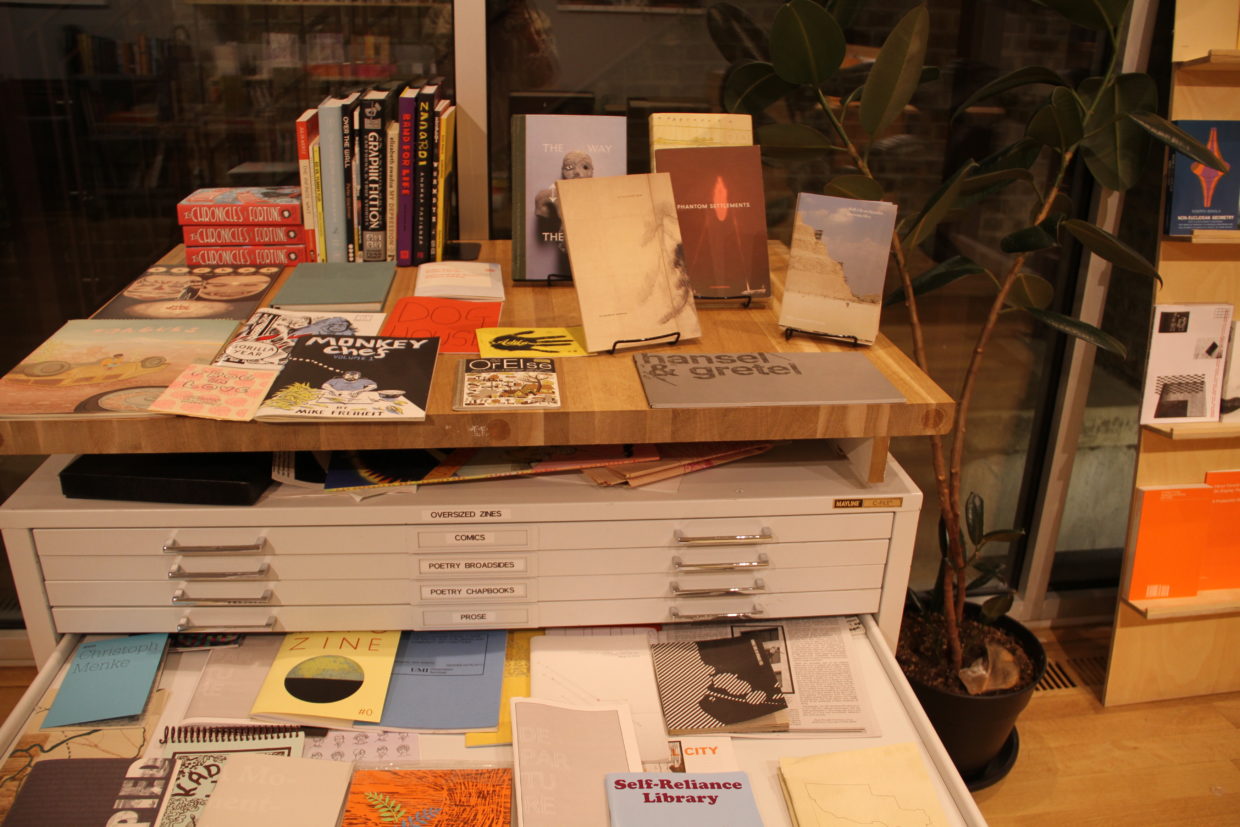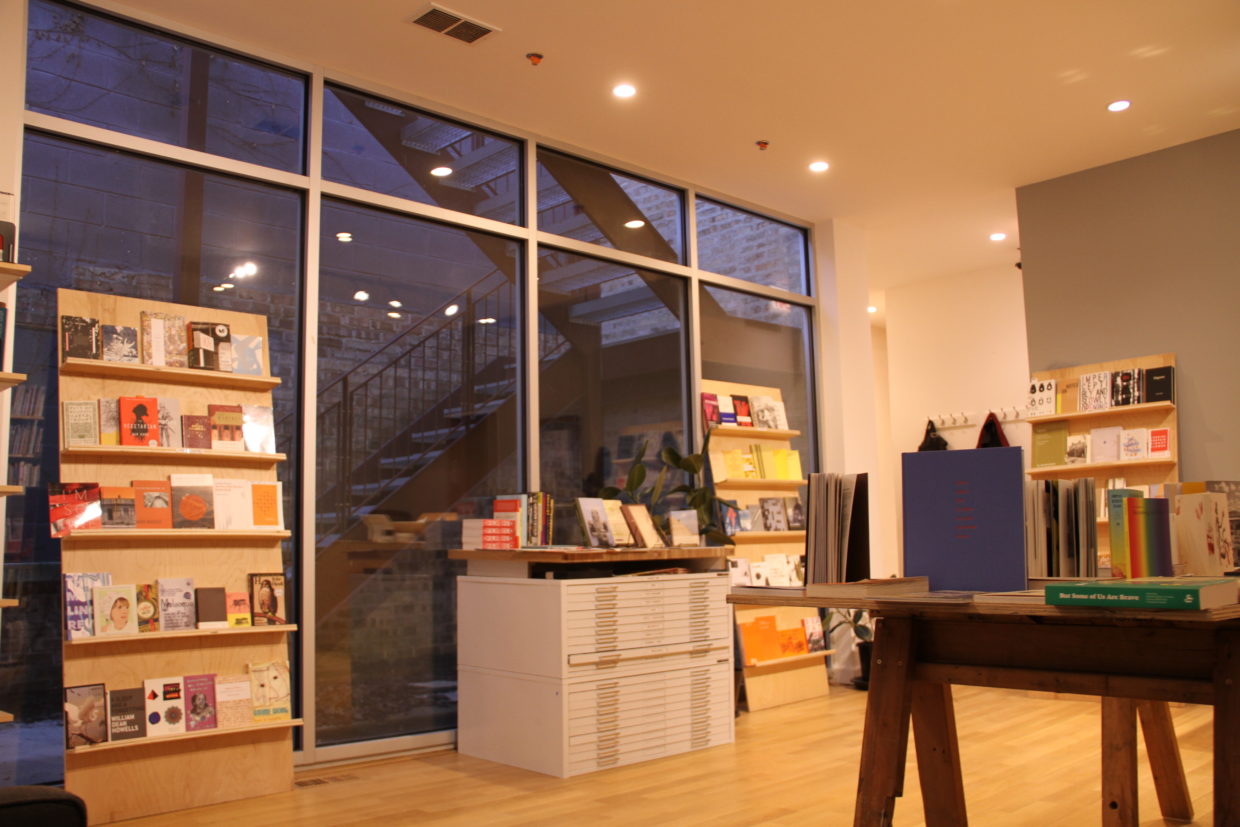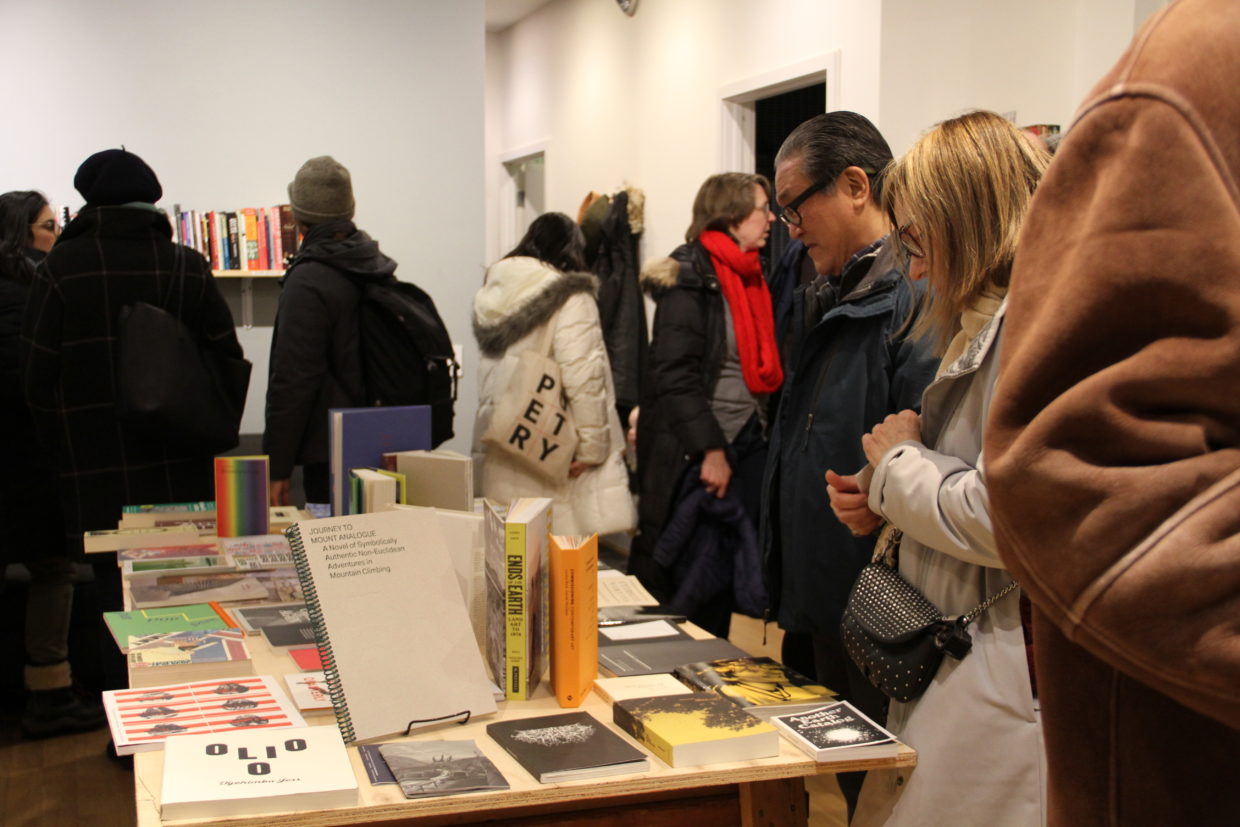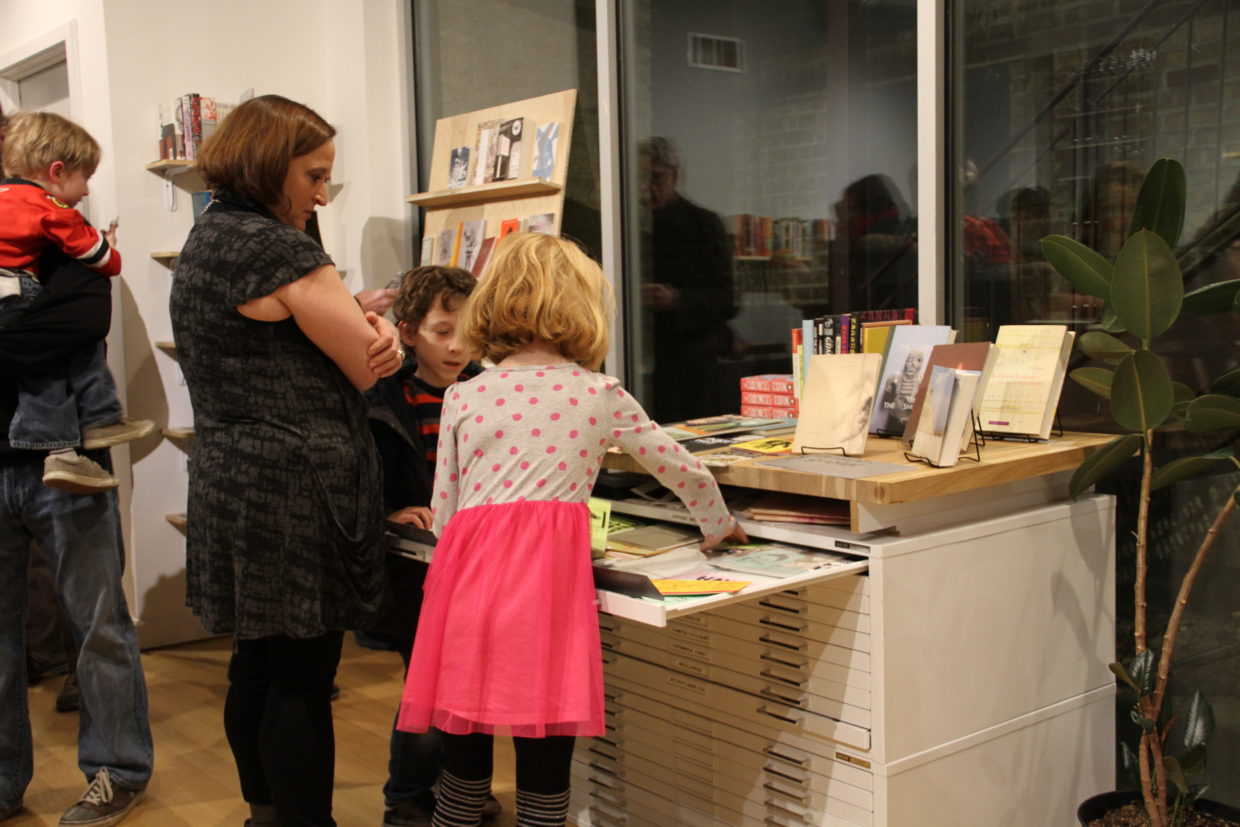
Sector 2337 Wants To Challenge What a Book can Be
Interview with a Bookstore: Sector 2337 + The Green Lantern Press
Located in Chicago, Sector 2337 began as The Green Lantern Gallery and Press in 2005. After closing in 2011 and re-opening briefly, it reopened again in Logan Square under its new name, Sector 2337, where it operates as a bookstore, gallery, and performance space. The Green Lantern Press continues to produce nonprofit exhibitions and books.

What would you say is your bookstore’s specialty?
Caroline Picard (Codirector, Sector 2337 and The Green Lantern Press): Poetry, small-batch contemporary art books, theory, and literature. We love small editions and independent presses. I also love art books from foreign countries and we carry a lot of those. Someone told me they felt like the Sector 2337 bookshop was the kind of place where you’d never find a mainstream title but instead leave with a book you’d never heard of and probably hadn’t imagined being made. I hope that’s true if only because when I find books like that, I am reminded that the world is full of unexpected possibilities.
Fulla Abdul-Jabbar (Assistant Editor, Green Lantern Press): Our store is really good at surprising people. In addition to our poetry, fiction, art + theory, and comics section, we have these large displays in the store that we try to switch up pretty regularly. There, we like to organize groupings of books across genres that resonate with the staff at the moment or that have contemporary relevance. So it’s common in our store that you’ll see an exquisitely produced art publication next to a poetry volume by an emerging author next to, say, Plato. We figure that since this is the way that books inhabit space in our homes and our minds, some of that genre play can be really fun when browsing more casually for a title and encountering something you would have never thought you needed in your life.
Sam Chao (Gallery Coordinator): How the bookstore attends to my scatteredness. I like how my moodiness is reassured as I can trust that there is always an experience that I can relate to in these shelves.
One day I had a sore throat and found an autoethnography, Visceral Poetics by Eleni Stecopoulos, on the poetry shelf. Simultaneously, I thought of a friend who decided to move back home to take care of his sick aunt. This would be a good book to sit with when you visit a friend or family member in a hospital and they happen to be sleeping. Another day I was feeling jetlagged and read Black Lavender Milk by Angel Dominguez.
Bec Hac (Bookstore Manager): A lot of our customers are invested in making their own books or publishing their own writing in some way. They come in with very specific, thoughtful concerns about how they want it to be, and find a lot of inspiration at our bookstore. Nearly every day I talk to someone who wants advice on a cover for their poetry chapbook, or recommendations for other publishers and art-book stores in the area. I think a lot of what we carry intends to challenge what a book can be, and you start to look at printed work, binding, content, everything that makes up a “book” in an exciting way.
Devin King (Codirector, Sector 2337 and The Green Lantern Press): Feeling good about knowing that 9 out of 10 other bookstores are filled with the same mainstream fiction.

What’s your favorite section of the store?
DK: This one shelf of used books that we have that has a copy of the Basic Writings of Heidegger, two Derek Raymond mysteries, and a Willa Cather book.
SC: The archive drawer for zines that Bec Hac set up. And the fact there is a place for pamphlets and zines. I like how thin and textural they are, the choice of paper, the montage element. I also like the reveal, when you open each drawer how they are laid out. In the unlabeled bottom drawers there are Green Lantern Press prints, and some of the archive, test proofs from the graphic designers for the Green Lantern Press.
BH: I like the table in the center of the bookstore. We can arrange the books visually, rather than alphabetically, so organizing it becomes intuitive.
What’s your favorite book to handsell?
FA: New Documents recently published Mr. Peanut Drawings, which collects said drawings by Canadian artist Vincent Trasov, who, in the 1970s, ran as Mayor of Vancouver as Mr. Peanut, complete with a top hat and cane. The book collects various drawings of Mr. Peanut in various poses and settings. There’s one I really like of Mr. Peanut as The Death of Marat. . . anyway, I highly recommend it.
SC: Hmm, that’s really hard to say, as we only have 1 to 2 copies. I like when people buy books after a poetry reading because it’s so rare and direct to be able to hear the writer speak. I also like the people who come in through the book. I also like when friends come in together. One friend recommends a book they read to the friend next to them. This friend would then buy the book the other friend recommended.
I also really like selling The Brightest Thing in the World by Matthew Goulish, one of our own Green Lantern Press titles, which is being reprinted with a new cover by Sonnenzimmer.
BH: We’ve published a book through Green Lantern Press, titled Diagrams, that shows “diagrams” of very abstract concepts, things that can’t really be visualized. For example, “Fate” is depicted as an arrow diving into a black box. There are diagrams for “Capital” and “Time” and more. None of them are labeled, so it’s fun to suggest it to customers, and watch them try to guess. The book becomes a game.
DK: I don’t know which word stresses me out more: mouthfeel or handsell.
What’s your favorite display? Do you have pictures?
DK: We had this plant one time that was pretty cool.
FA: In the summer, in addition to the space in the back, we convert the entire gallery space into a bookstore. For the plant section Devin refers to, we put together all of our plant-related books together on a shelf. There were quite a lot since we had recently published Imperceptibly and Slowly Opening at the press, which deals with questions of plant consciousness. It then only felt right to crowd the plants near this section. Devin then brought in a typewriter that he had and we set it up in front of our fern. Sam then put the fern’s leaves on the keyboard, and we typed out “Leaves of Grass Pt. II” We were all pretty proud of that.

Tell us about your most memorable author event.
BH: We recently hosted an event featuring two poets, who read their poems alongside moving projections a few feet tall and wide. “Performing” projected images is format that’s present in other events around Chicago—for example, Lyra Hill’s Brainframe, and Matt Davis and Brad Rohloff’s Zine’s Not Dead. There’s a new energy, but also disorientation—There’s no hierarchy between the text, the performer, and the projection. It’s enthralling.
SC: The muscular transition when Jordan Scott introduces and reads his work. He really controls and marks his stutters when he reads, and when he introduces the next poem he stutters, then goes back to the articulated stutter to the next poems.
DK: There was this one time that someone read and wasn’t trying to sound like they were trying out for an improv class. I liked that one.
What’s your message to Amazon (and Amazon customers)?
CP: Initially, the bookstore began as an online shop that enabled us to sell Green Lantern Press titles that we’d published alongside small press titles that we not only loved but also helped contextualize our agenda as publishers. It was an initiative partly born out of frustration with Amazon’s steep pricing policy and impersonal bureaucratic back end maze—all things that made running a small press with prohibitive. We wanted to have more agency while connecting more directly to our audience. Since then, the bookstore has grown into a brick-and-mortar enterprise that offers another point of entry to our cultural programs. Bookstores are awesome because they become watering holes, sites for reading groups, and casual conversation.
DK: Are we really still trying to win this battle?
SC: For the “look inside” function, I wonder about being able to scan the pages of the books. I want to know to the division of labor of scanning and digitizing books. I am also very confused about the scale diagrams they have now, where the size of the book is in relation to a person’s upper body.
Do you have a foreign language section, and if so, what’s your advice for building a section of not books that are not written in English?
CP: We do have some foreign language books, but most of these are mixed in with the regular titles and most include English translations. When possible, that’s my favorite mode as it shows a connection between the original language and its corresponding depiction. Our in-house publisher, the Green Lantern Press, published Nick Sarno’s translation of A Season in Hell like this and I think it’s a really generous approach to translation. Similarly, we have hosted events associated with MAKE Magazine’s Lit + Luz Festival and they are keen on presenting the Spanish and English translations alongside one another, while hosting discussions specifically about translation.
SC: We have self-translated books. There are also many accents of English. So a suggestion is if you could organize the many accents of English. This could familiarize and adapt to building a foreign language section. But definitely not alphabetically.
DK: Of course we do. Advice: do you want to have a section of non-English books? Buy some books in a foreign language!

Do you have bookstore pets or animal regulars? If so, can you please provide pictures and describe their personalities?
DK: No pets, but we have a Manimal named Darby.
CP: Almost all of the plants in our shop (with the exception of our only named bookstore resident, “Robert Plant,” who was rescued from a dumpster four years ago) appeared in a past performance at the gallery. There are two smaller Rubber Plants that starred in Katherine Behar’s High Hopes (Deux) where they danced around the gallery on Roombas; the other plants appeared in at some point in our Annual Festival of Poets Theater that Devin King and Patrick Durgin co-curate each year. Everything has grown so much since their respective performances that they are hard to recognize.
SC: There were a lot of birds, but I think they came more because of Rebecca Beachy’s gravel path of cremated horse bones for our Coming of Age exhibition. They eat them as it’s a good source of calcium. But we have a lot of succulents and rubber trees. The plants are very shy and confident. They are thirsty on Sundays. The rubber plants nest their leaves. When the leaves fall, the trunks cradle them in the center.
FA: Our store has these very large windows at the front that faces a stretch of Milwaukee Ave that gets a lot of dog traffic. Shout out to all those great dogs.
If you had infinite space what would you add (other than a bar/restaurant)? Be specific.
CP: A bigger area specifically dedicated to readings and performances would be awesome. Right now we have a large main gallery space with a bar and we host regular readings in our bookstore, but it would be awesome to have a space specifically for a seated audience and live performance. In the past we have hosted larger crowd performance events in the main gallery, but this only works with select exhibits or when the gallery is empty.
FA: I’d love to expand our seating area. It’s always great to have some space to lay out all of the books I want to get as I make my decision on which ones I will take home.
SC: I would like a space for video. It would be great to have collection of video essays that people can preview in a dark room with a projector.
DK: Infinite space would imply infinite time, so I’d say a well-lit house with a few of my friends and family in it and, like, some canned goods.
Who’s your favorite regular?
CP: We have a great audience of support. We host roughly 50 free public programs a year with a lot of repeating customers. I’m not sure I could pick a favorite customer. I will say that I appreciate the way our audience is comprised primarily of writers, artists, professors, students, and then folks from our immediate neighborhood or visitors from out of town. Often people who come to one event present their own work at another. The conversation before, in between, and after, feels warm and dynamic as a result.
SC: I forgot her name but she makes smoothies next door, in the Chicago Diner. She buys really fun books, the most recent being Sleep Cures Sleepiness by Martin Kohout. I also like when my roommates drop by. Hunter when he comes in after the farmer’s market. Hannah when she comes in to look for gifts to give to friends back home but gifts herself poetry, film books, and books with black covers. Jean comes in to buy a book that revisits a conversation that we’ve had.
DK: Big Steve!



















